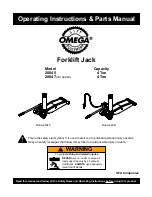
ABOUT WELDING
(continued)
TIG welding in general:
TIG welding requires an inert gas, 100% Argon or an Argon mix (start with 100% Argon if you are new to welding). So
you will need a tank of Argon to hook to the gas inlet on the back of the unit. Put a fitting so you can swap the air com-
pressor for your Plasma cuts and Argon tank. Hint, get one size bigger on the argon tank as it costs about the same to
get twice as much on the refill.
TIG also requires a tungsten electrode (not included). The argon and electrode are not parts you would get with any
welder. So you “will” need to visit the welding store before you TIG. TIG welding will give you the best control over your
welds, keep the heat right on the area you want to weld (reduces warping), and probably give you the strongest weld if
done right (ok all welds are strong if done right). TIG will look nicer over all electrical welding methods. Even as a nov-
ice you can make a nice bead with some practice.
As far as the tungsten electrodes, there are two general types and a few different sizes (diameter). The first type is the
(green tip) ”pure tungsten” for aluminum TIG AC welding and the (red tip) “tungsten 2% thoriated” for TIG DC or pulsed
steel and stainless steel welding. I will list what I use here shortly, but let’s get back to the Everlast Super series TIG.
With your supplies you will see you have 1/16, 3/32, 1/8 inch collets to allow for different electrode sizes. You might
have larger in your set. I keep 1/16 and 1/8 inch for steel (thoriated/red; steel DC welding;). 3/32 and 1/8 inch pure
tungsten for aluminum (green). They are 7” long.
Before you install the tungsten electrode you will need to sharpen the tips. The point taper should be 2.5 time the diame-
ter on the electrode tip as a general rule. The steel tungsten electrodes (red tip) should be sharpened to a very sharp
point on the end and sharpened with the length of the rod not across the point. Aluminum you want a ball on the end (if
it ’s not a perfect ball, it will be after you use it, so that is not so critical). And it should be sharpened with the length as
well. Now let’s see how to put the electrode in the torch.
On the top (back side ) of your torch you will have the short black “back” cap and in the accessory bag you will see a
longer black “back” cap, which is for the 7” electrodes you picked up at the welding store. Along with the longer back
cap, there are ceramic cups (pink) of varying sizes 5-7 to output the shielding Argon gas. The larger the cup the better
(unless you are doing small gauge flat metals). The smaller cups and short back cap are for welding in tight areas so
you can get the torch in tight spots. (you will need to cut an electrode down to use the short back cap). On the bottom of
the torch you have the cup (pink ceramic). This sends the gas out to protect the metal from oxidation as you weld (heat)
the metals. Also in the bag there are collets for the different size diameter tungsten electrodes you can use.
If you have sharpened your tungsten electrode, unscrew the short back cup shipped on the torch (and get the larger long
back cap from the bag). Take out the collet inside the torch (under the back cap; the cap pushes the collet to lock your
tungsten electrode in place). Match your electrode with the correct collet size. Insert the collet and tungsten electrode
and put on the long back cap and start to tighten. Make sure you have from 1/8 to 1/4 inch of the tungsten electrode
sticking out below the bottom of the (pink) cup. At this point you have the gas hooked up, the torch ready for steel or
aluminum. You will want to set your Argon gauge from 10-25 cfh (cubic feet per hour). I normally shoot for 20.
To set the gas pressure gauge you will have to press the torch switch or pedal and waste a little gas, but you need to
purge the air from the line anyway..
TIG DC
If you reference page 7 (TIG DC) of this manual, it has the setup information for DC TIG. Use this to set your control
panel. DC TIG is good for steel, stainless and carbon steel. Your tungsten electrode (red tip; thoriaded) should have a
sharp point. With a longer point, you have a more precise and narrow TIG arc. As mentioned above, set your gas to
20cfh, the controls, prep (clean) your work pieces, clamp them together and connect the ground clamp. At this point you
are ready to TIG. Start by evenly heating the two parts you want to weld. Watch for a pool of metal to form. When you
see the pool and glow, you are ready to dip the rod in the pool and remove it. You then move the torch and repeat this
operation. You might want to tack weld each end first so you can remove the clamps and then run your bead.
If you are right handed, use the torch in your right hand and the left to dip the (308 stainless steel or W-1200 steel) filler
rod you purchased in the type work piece you are welding.
USERS
’
MANUAL EVERLAST CT-D series
- 12 -
Содержание CT416
Страница 2: ......





































